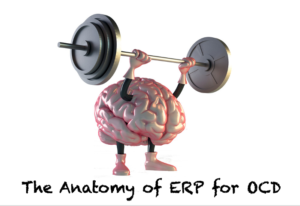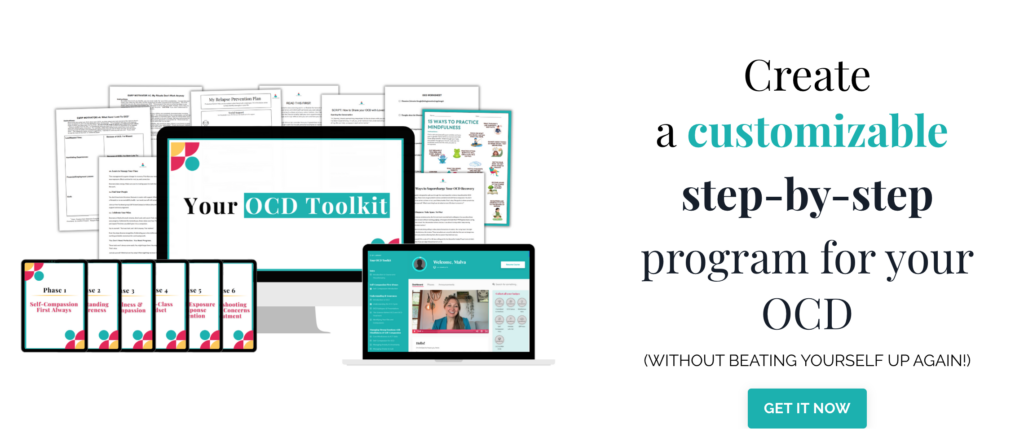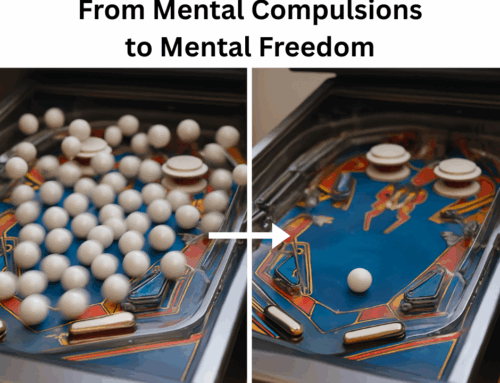So how exactly do I approach ERP (exposure and response prevention therapy) for OCD? I share the anatomy of ERP for OCD below, but before we get started, let me define the difference between proactive and reactive ERP.
Proactive vs. reactive ERP
- Proactive ERP is when you’re purposely triggering OCD by doing something that is important to you that your OCD doesn’t like, i.e. you choose the timing and content.
- Reactive ERP is when your OCD gets triggered and you respond by using a variety of ERP skills, i.e. your OCD chooses the timing and content.
Sometimes when you’re doing proactive ERP, OCD will trigger you about something else, and then you’re doing a combination of proactive and reactive ERP. (A good example of this is my Making OCD Pass Out video.) After you’ve finished a proactive ERP session, you’ll probably need to do reactive ERP in the hours after the exposure because you’ve riled up your OCD about that topic and it might decide to poke you back.
Taming OCD requires both proactive and reactive ERP. If you’re only doing reactive ERP, then OCD is unfortunately in charge of your recovery, because you’re only poking at it when it pokes you first.
The Anatomy of ERP for OCD

A few months ago I was on a Zoom call with a friend on a Sunday evening when he said something that made my OCD completely melt down. It was one of those 0 to 60 moments, where one minute I was fine and the next I was awash in adrenaline with my OCD having a tantrum on the floor. (Personifying my OCD has been an exceptionally useful tool in my OCD recovery, by the way…)
But it’s okay, this happens at times because there’s no cure for OCD, and you can still live a joyful life anyway, especially if you embrace all the ERP tools available.
To help you in this process, here are the steps I took and the tools I used to manage that episode. I’ve written extensively about all of these tools, and I’ve linked to other blog posts or resources where you can learn more about each.
- Welcoming, empowering attitude
- Welcome this trigger. “OCD, I’m so glad my friend said what he did and got you upset because I needed a chance to practice! I’m taking my fear and transforming it into excitement about beating you, OCD, because I’m not letting you steal any more of my life!”
- Adopt a power pose and empower myself: “I know this is hard, but as Kimberley Quinlan says, ‘it’s a beautiful day to do hard things,’ and I can do this! I am doing this! I have reclaimed my life before and I will do it again, OCD!”
- Trash talk OCD, asking for more. “OCD, is that all you’ve got for me? Come on, I want something scarier. Bring it on!!”
- Infuse this with a fair bit of swearing, just because it’s fun and makes me feel more powerful in the face of this bully.
- Self-compassion: OCD is a monster. I wish no one had to go through terrifying, debilitating OCD episodes. And no one handles them perfectly, including me, and I’m an OCD therapist! So I’m going to give myself compassion: “I’m feeling humbled, overwhelmed, and anxious. Many people who are blindsided by OCD feel this way. But I’m going to give myself a break. I feel a tremendous sense of resolve to remind OCD that it’s not in charge. I’m going to give myself permission to be imperfect, even though I’m an OCD therapist. I’m going to do this ERP joyfully and then focus on enjoying the rest of my night as best as I can.”
- Proactive ERP
- Intentionally doing something that I want to do that OCD doesn’t like. I call this torturing my OCD with the goal of making it pass out! While doing this, I also actively incorporate the attitude components, remembering to want my anxiety because that’s how I tame OCD and reclaim my life.
- Saying “may or may not” scripts while I poke OCD to 1) keep the scary aspects of this trigger mindfully and intentionally present so that my OCD can face them, 2) help me get to the root of what OCD is afraid of, typically some variation of “I’m a bad person,” so I can target that in my ERP and 3) keep me from interacting compulsively with this content (i.e. response prevention) as I work on the exposure.
- Finishing by once again giving myself some compassion.
- Reactive ERP
- Putting my shoulders back and mindfully focusing on getting on with my day, refusing to engage with the OCD in my head. If I have trouble with this, I use “may or may not” scripting to interrupt the cycle of mental rituals and/or do a quick proactive ERP and then go back to acting like OCD is irrelevant.
- Acting joyful, like all this OCD content is irrelevant. This is the essence of good ERP. And because if I don’t, I’ll be doing the subtle compulsion of acting depressed, like all this is true, and sabotaging everything I just did.
- Continuing to give myself compassion, knowing that I might feel a little more anxious and tired today because of doing the ERP.
- Mindfulness: Meditate each day and stay in the present moment as much as possible. OCD is what’s happening in my head; it’s not actually the real life that’s right in front of me. Cultivating mindfulness helps me to remember that and focus on what matters in the here and now.
- Repeat Steps 1-5 in any order as often as I need to until OCD stops being a melting-down Triad of Hell and instead reverts to the docile orange ball version of itself (with big feet and sunglasses) who sits on the floor and quietly knits and mostly leaves me alone. For more about my personification of OCD, my dynamic relationship with it, and some fast-paced OCD-taming stories, see Is Fred in the Refrigerator? Taming OCD and Reclaiming My Life.
Your OCD Toolkit
Would you like to do a deep dive into the anatomy of ERP for OCD? Check out Your OCD Toolkit, created by Kimberley Quinlan, LMFT, one of the most talented ERP therapists I know.
Learn more about taming OCD
Sign up for my Shoulders Back! newsletter to receive OCD-taming tips & resources, including notifications of new blog posts, delivered every month to your inbox.
My blogs are not a replacement for therapy, and I encourage all readers who have obsessive compulsive disorder to find a competent ERP therapist. See the IOCDF treatment provider database for a provider near you. And never give up hope, because you can tame OCD and reclaim your life!
Weightlifting brain image © Can Stock Photo / abidal








Glad I found this article. I was able to learn a lot about this topic. Everything is clear to me now, thank you for posting this article, great work.
I found this article reliable and useful that is why I appreciate this a lot. I was able to gain plenty of ideas. I believe this blog will help a lot of readers. It is worth reading and sharing.
Dear Shala,
I just read your article: “The Subtle OCD Compulsion You Might Not Know You’re Doing” for Psychology Today and I LOVE LOVE LOVE IT! For the first time, I can finally understand the subtle trick ROCD has been doing. There was always a missing puzzle and you just gave me the info I needed. Now I will so kick OCDs ass again! Your articles and your work are amazing.
Thank you from the bottom of my heart!
Sending you all my love from Croatia,
Helena
That is wonderful to hear, Helena! And thank you so much for your kind words.